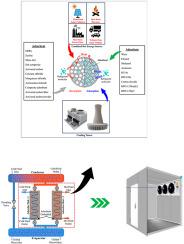Recent advancements and sustainable solutions in adsorption-based cooling systems integrated with renewable energy sources and industrial waste heat: A review
IF 6.5
Q2 ENGINEERING, ENVIRONMENTAL
引用次数: 0
Abstract
This work aims to compile the factors that impact the adsorption system's performance. The functional performance and operations of adsorption cooling systems are greatly influenced by the mass and heat diffusion across the adsorber bed, adsorbates-adsorbent pairs, cycle type, cyclic period, and the adsorber bed design. Generally, enhancing heat transport across the bed will decrease the thermal resistance, shortening the cycle time and eventually increasing the COP. To enhance the operational efficiency of the adsorption system, researchers have explored a few more adsorption cycles in addition to those that have already been studied. Some of the typical cycles like the multiple-adsorber bed cycle, surface cascading adsorption cycle, thermal wave cycle, mass-recovery cycle, and heat recovery cycle, are discussed in this work, unlike the previous work, making it helpful for design basis and enhancing the system's performance. A system having numerous beds offers a continual cooling effect and having minimal dead mass operates more efficiently. Combining all the contributing elements listed above provides superior outcomes and efficient performance for adsorption cooling systems. Generally, adsorption cooling technology has been oversimplified which means they don't fully explain the detailed physics of adsorption cooling technology, making it less percolated and technically less efficient. Current studies aim to understand these complex intricate physics better so that the adsorption system can be improved and correlated with various notes of adsorption technology to make it more widely accessible for commercial use.

与可再生能源和工业余热相结合的吸附式冷却系统的最新进展和可持续解决方案:综述
这项工作旨在汇编影响吸附系统性能的因素。吸附冷却系统的功能性能和运行在很大程度上受吸附剂床层的质量和热扩散、吸附剂-吸附剂对、循环类型、循环周期和吸附剂床层设计的影响。一般来说,加强吸附床的热传导会降低热阻,缩短循环时间,最终提高 COP。为了提高吸附系统的运行效率,除了已经研究过的吸附循环外,研究人员还探索了更多的吸附循环。与以往不同的是,本论文讨论了一些典型的循环,如多吸附床循环、表面级联吸附循环、热波循环、质量回收循环和热回收循环,这有助于为设计提供依据并提高系统性能。拥有多个冷却床的系统可提供持续的冷却效果,而且死体积最小,运行效率更高。综合上述所有因素,吸附冷却系统就能获得卓越的效果和高效的性能。一般来说,吸附冷却技术被过度简化,这意味着它们没有充分解释吸附冷却技术的详细物理原理,使其渗透性和技术效率较低。目前的研究旨在更好地理解这些复杂错综的物理学原理,从而改进吸附系统,并与吸附技术的各种注意事项相关联,使其更广泛地用于商业用途。
本文章由计算机程序翻译,如有差异,请以英文原文为准。
求助全文
约1分钟内获得全文
求助全文
来源期刊

Cleaner Engineering and Technology
Engineering-Engineering (miscellaneous)
CiteScore
9.80
自引率
0.00%
发文量
218
审稿时长
21 weeks
 求助内容:
求助内容: 应助结果提醒方式:
应助结果提醒方式:


